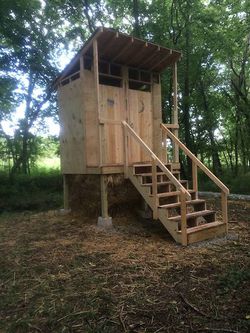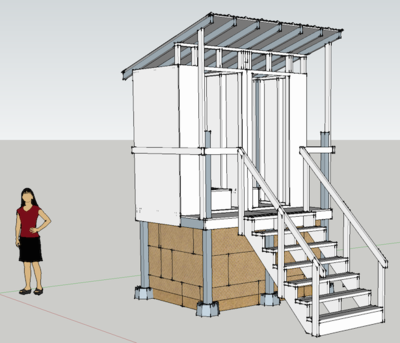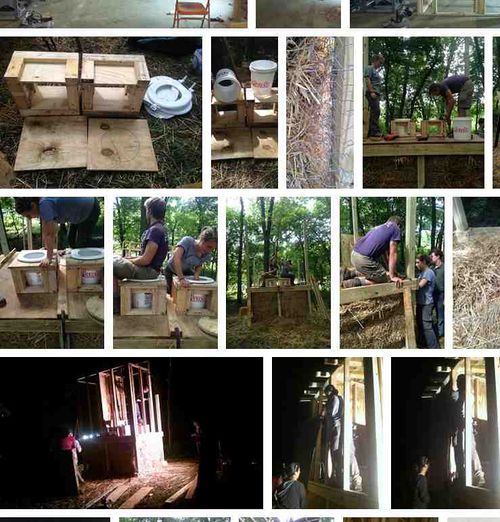Composting Toilet
Main > Food and Agriculture > Soil and compost
Main > Housing and construction > Home fittings
Current Design, 2014
Our design is an above-ground, low-maintenance moldering composting toilet that is intended for large groups (workshop participants, interns) over a short term. The toilet facilitates the decomposition of humanure in an isolated straw-bale chamber.
It is based on Nancy Rosalie's Common Throne for the Common Ground Fair in Unity, Maine.

|

|
Trovebox Album
For more photos of the building process, this is the complete Photo Album
Introduction
What is “humanure”?
Humanure (human manure) is human fecal material and urine. It can be a major source of environmental pollution around the world. It also can be a source of disease organisms. When discarded into the environment as a waste material, it creates pollution and threatens public health. When recycled by composting, the pollution and health threats can be eliminated. Humanure contains valuable soil nutrients that enhance plant growth. For these reasons, humanure should be recycled whenever possible.
What is composting?
Composting is the feeding of organic material such as humanure and food scraps to small organisms such as beneficial bacteria. Many compost organisms are too small to be seen, however, many of them can be seen. The larger ones include earthworms and many other tiny insects. Fungi also live in compost piles and they digest the tougher, woody plant materials.
- Definitions from Joseph Jenkins,Humanure Handbook)
How does it work?
Humanure, when collected and contained in an enclosed environment, and combined with carbon based cover material, goes through a process of aerobic decomposition to create nutrient rich humus. This process destroys pathogens and allows bacteria to thoroughly decompose the refuse material. With the appropriate conditions, with correct air flow, temperature, carbon:nitrogen ratio, the human refuse will aerobically decompose into nutrient rich humus.
Why?
In contemporary society, we have broken the ecology of the human nutrient cycle. Factory farms apply chemical fertilizers to agricultural land, in order to support the vegetation. Consumers then discard refuse and flush away their ‘waste’ to sewers and landfills, sacrificing valuable nutrients and polluting drinking water.
Open Source Ecology, as an educational hub, has an obligation to demonstrate the possibility of reintegrating ourselves within the environment, starting with the most basic of human functions; eating, digesting, and excreting waste, and transforming our byproducts into valuable resources. The composting toilet is directly in line with the basic mission of OSE, to preserve water and provide soil nourishment, which are essential for the revitalization of the landscape and resilience for the future.
Use and Maintenance of Current System
- Limit liquids and moisture (no urine) in chamber, in order to maintain appropriate moisture content in chamber, and reduce odors
- After each visit to the toilet, add just enough sawdust to completely cover your contribution
- Close toilet lid and open stall doors after each use to limit flies and odor
- Weekly cleaning:
- Clean 5 gallon bucket "poop chutes" - minimize use of water, and only a tiny amount of biodegradable soap (e.g. Dr. Bronners) if necessary
- Sweep out chambers, deck, and stairs
- Restock toilet paper (ideally bleach free)
- Replenish sawdust (from nearby sawmill or our own workshop - NOTE: Clean sawdust only; e.g. NO Hydraulic fluid, NO treated lumber dust, NO pink foam dust)
- When the chamber is filled to capacity, (determined by users, after the summer season of workshops/interns) the toilet should be closed and left undisturbed for 8 to 12 months. This is when the composting process will occur.
- After approximately 8 months to 1 year, the back wall of straw-bales is removed and the finished compost is shoveled from the chamber. Composted humus should be ready for laying around trees and ornamental plants; NOT recommended for vegetable gardening. New straw-bales are added as needed, and the process begins again.
*Recommended Fallow Period: October 1st - June 1st - this will allow 8 months for composting
Work Still Needed
In rough priority order
- Seal, stain, or paint the toilet
- Remove doors and metal hardware
- Paint metal hardware with spraypaint (black?)
- Paint or seal doors, stair treads, and railings. Consider sealing/painting exposed 2x4 wall framing, roof rafters. Especially focus on sealing/painting the end grains of all exposed untreated wood.
- Ask Sutherland's or Menard's what they recommend for deck or shed sealing/painting
- DO NOT seal or paint Treated Lumber before 2015 June 1. Treated lumber is greenish in hue and includes: stair stringers, ribbon/rim joists, 3/4" deck plywood, 1/2" sheathing plywood. It needs to breath and dry out before it can be safely sealed or painted.
- Anchor the toilet for wind protection using earth anchors and cables / turnbuckles.
- Make good signage, including:
- "CLOSED FOR COMPOSTING. October 1st - June 1st
- Instructions for use
- Instructions for cleaning
- Philosophy & theory of composting toilets
- Good documentation of build, here on the Wiki or on Dozuki
- Add 1/4" plywood sides to seatboxes to hide the bucket/"poop chutes"
Proposed Timeline
October 1st, 2014: Close toilet for composting.
June 1st, 2015: Re-open and collect decomposed material with arrival of new interns. Add new straw-bales for chamber as needed.
Yes, compost:
feces, urine, menstrual blood
sawdust
toilet paper
toilet paper rolls (cardboard)
paper or cotton based feminine hygiene products
No, do NOT compost:
plastics
plastic feminine hygiene products
The Plans
SketchUp
Dozuki
Previously Used System, 2012
This is the exact technique for a simple composting toilet that we use at Factor e Farm (from a Humanure Handbook, (see exact page and further pictures):
“How it works is a model of simplicity. One begins by depositing one’s organic refuse (feces and urine) into a plastic bucket, clay urn, or other non-corrodible waterproof receptacle with about a five gallon (20 liter) capacity. Food scraps may be collected in a separate receptacle, but can also be deposited into the toilet receptacle. A five gallon capacity is recommended because a larger size would be too heavy to carry when full. If five gallons is still too heavy for someone to carry, it can be emptied when half-full.
The contents of the toilet are kept covered with a clean, plant-based cover material such as rotted sawdust, peat moss, leaf mould, rice hulls, or grass clippings, in order to prevent odors, absorb urine, and eliminate any fly nuisance. Urine is deposited into the same receptacle, and as the liquid surface rises, more cover material is added so that a clean layer of organic material covers the toilet contents at all times.
A lid is kept on the toilet receptacle when not in use. The lid need not be air-tight, and a standard, hinged toilet seat is quite suitable. The lid does not necessarily prevent odor from escaping, and it does not necessarily prevent flies from gaining access to the toilet contents. Instead, the cover material does. The cover material acts as an organic lid or a “biofilter”; the physical lid (toilet seat) is used primarily for convenience and aesthetics.”
The idea of a composting toilet is to keep compost around 43-50°C (110-122°F) for at least a week, to create an environment in which beneficial microorganisms thrive and pathogenic ones die. The Humanure Handbook says, "A sound approach to pathogen destruction when composting humanure is to thermophilically compost the toilet material, then allow the compost to sit, undisturbed, for a lengthy period of time after the thermophilic heating stage has ended."
The way to accomplish this is:
- Use sawdust to bury manure. Sawdust provides carbon and this balances the nitrogen in the faeces. A good carbon-nitrogen balance is needed for composting. The sawdust also keeps bad smells in and keeps flies away. Biochar could also profitably be used for this purpose.
- Do not seperate urine and feces, as the urine provides moisture the microorganisms need.
- As well as adding the buckets from the toilet to the compost heap, throw on chunky materials like straw. This traps air pockets in the compost heap.
- Optionally, skewer the compost heap with sticks or pipes to provide more aeration.
- Let it sit for a year before using on plants
Resources
- The Humanure Handbook, 3rd edition here
- Moldering Toilets
- Terra Preta Toilet
- Natural Toilets
